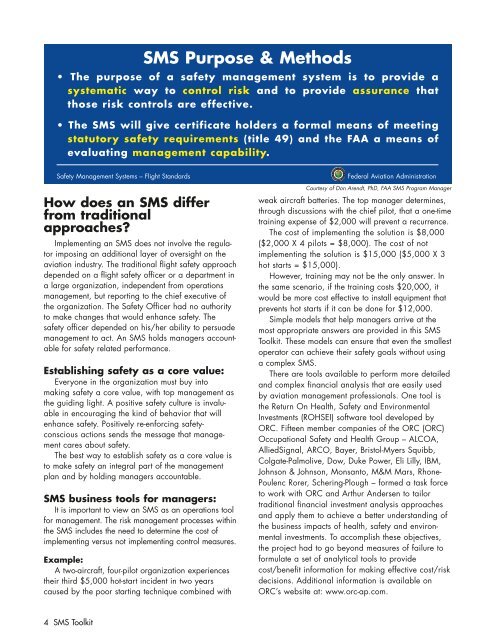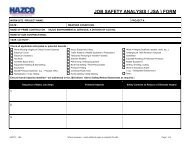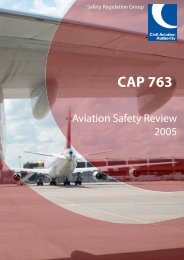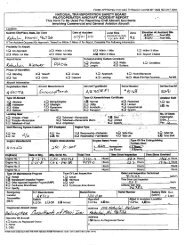International Helicopter Safety Team Safety Management System Toolkit
IHST - Safety Management Toolkit - Skybrary
IHST - Safety Management Toolkit - Skybrary
- No tags were found...
Create successful ePaper yourself
Turn your PDF publications into a flip-book with our unique Google optimized e-Paper software.
SMS Purpose & Methods<br />
• The purpose of a safety management system is to provide a<br />
systematic way to control risk and to provide assurance that<br />
those risk controls are effective.<br />
• The SMS will give certificate holders a formal means of meeting<br />
statutory safety requirements (title 49) and the FAA a means of<br />
evaluating management capability.<br />
<strong>Safety</strong> <strong>Management</strong> <strong>System</strong>s – Flight Standards<br />
How does an SMS differ<br />
from traditional<br />
approaches?<br />
Implementing an SMS does not involve the regulator<br />
imposing an additional layer of oversight on the<br />
aviation industry. The traditional flight safety approach<br />
depended on a flight safety officer or a department in<br />
a large organization, independent from operations<br />
management, but reporting to the chief executive of<br />
the organization. The <strong>Safety</strong> Officer had no authority<br />
to make changes that would enhance safety. The<br />
safety officer depended on his/her ability to persuade<br />
management to act. An SMS holds managers accountable<br />
for safety related performance.<br />
Establishing safety as a core value:<br />
Everyone in the organization must buy into<br />
making safety a core value, with top management as<br />
the guiding light. A positive safety culture is invaluable<br />
in encouraging the kind of behavior that will<br />
enhance safety. Positively re-enforcing safetyconscious<br />
actions sends the message that management<br />
cares about safety.<br />
The best way to establish safety as a core value is<br />
to make safety an integral part of the management<br />
plan and by holding managers accountable.<br />
SMS business tools for managers:<br />
It is important to view an SMS as an operations tool<br />
for management. The risk management processes within<br />
the SMS includes the need to determine the cost of<br />
implementing versus not implementing control measures.<br />
Example:<br />
A two-aircraft, four-pilot organization experiences<br />
their third $5,000 hot-start incident in two years<br />
caused by the poor starting technique combined with<br />
Federal Aviation Administration<br />
Courtesy of Don Arendt, PhD, FAA SMS Program Manager<br />
weak aircraft batteries. The top manager determines,<br />
through discussions with the chief pilot, that a one-time<br />
training expense of $2,000 will prevent a recurrence.<br />
The cost of implementing the solution is $8,000<br />
($2,000 X 4 pilots = $8,000). The cost of not<br />
implementing the solution is $15,000 ($5,000 X 3<br />
hot starts = $15,000).<br />
However, training may not be the only answer. In<br />
the same scenario, if the training costs $20,000, it<br />
would be more cost effective to install equipment that<br />
prevents hot starts if it can be done for $12,000.<br />
Simple models that help managers arrive at the<br />
most appropriate answers are provided in this SMS<br />
<strong>Toolkit</strong>. These models can ensure that even the smallest<br />
operator can achieve their safety goals without using<br />
a complex SMS.<br />
There are tools available to perform more detailed<br />
and complex financial analysis that are easily used<br />
by aviation management professionals. One tool is<br />
the Return On Health, <strong>Safety</strong> and Environmental<br />
Investments (ROHSEI) software tool developed by<br />
ORC. Fifteen member companies of the ORC (ORC)<br />
Occupational <strong>Safety</strong> and Health Group – ALCOA,<br />
AlliedSignal, ARCO, Bayer, Bristol-Myers Squibb,<br />
Colgate-Palmolive, Dow, Duke Power, Eli Lilly, IBM,<br />
Johnson & Johnson, Monsanto, M&M Mars, Rhone-<br />
Poulenc Rorer, Schering-Plough – formed a task force<br />
to work with ORC and Arthur Andersen to tailor<br />
traditional financial investment analysis approaches<br />
and apply them to achieve a better understanding of<br />
the business impacts of health, safety and environmental<br />
investments. To accomplish these objectives,<br />
the project had to go beyond measures of failure to<br />
formulate a set of analytical tools to provide<br />
cost/benefit information for making effective cost/risk<br />
decisions. Additional information is available on<br />
ORC’s website at: www.orc-ap.com.<br />
4 SMS <strong>Toolkit</strong>







